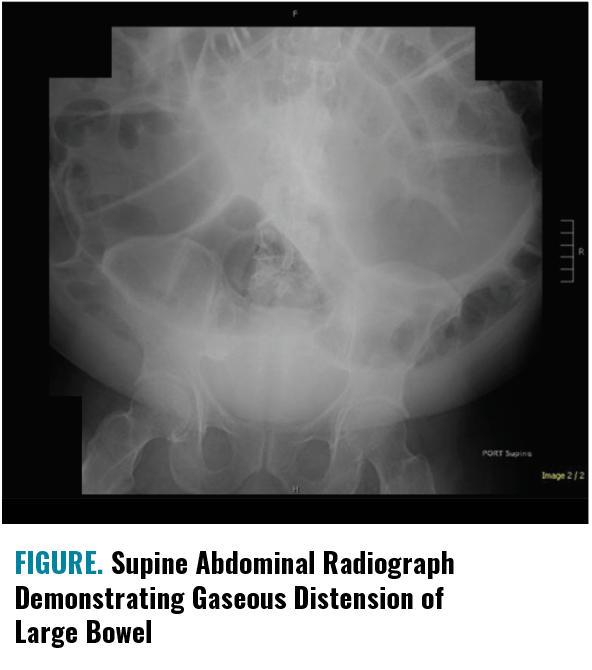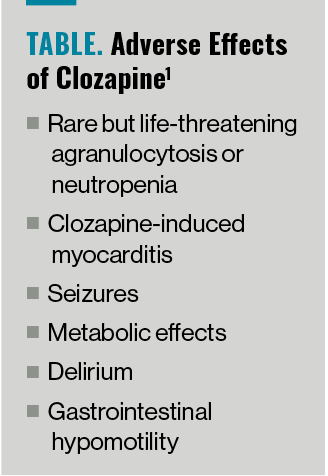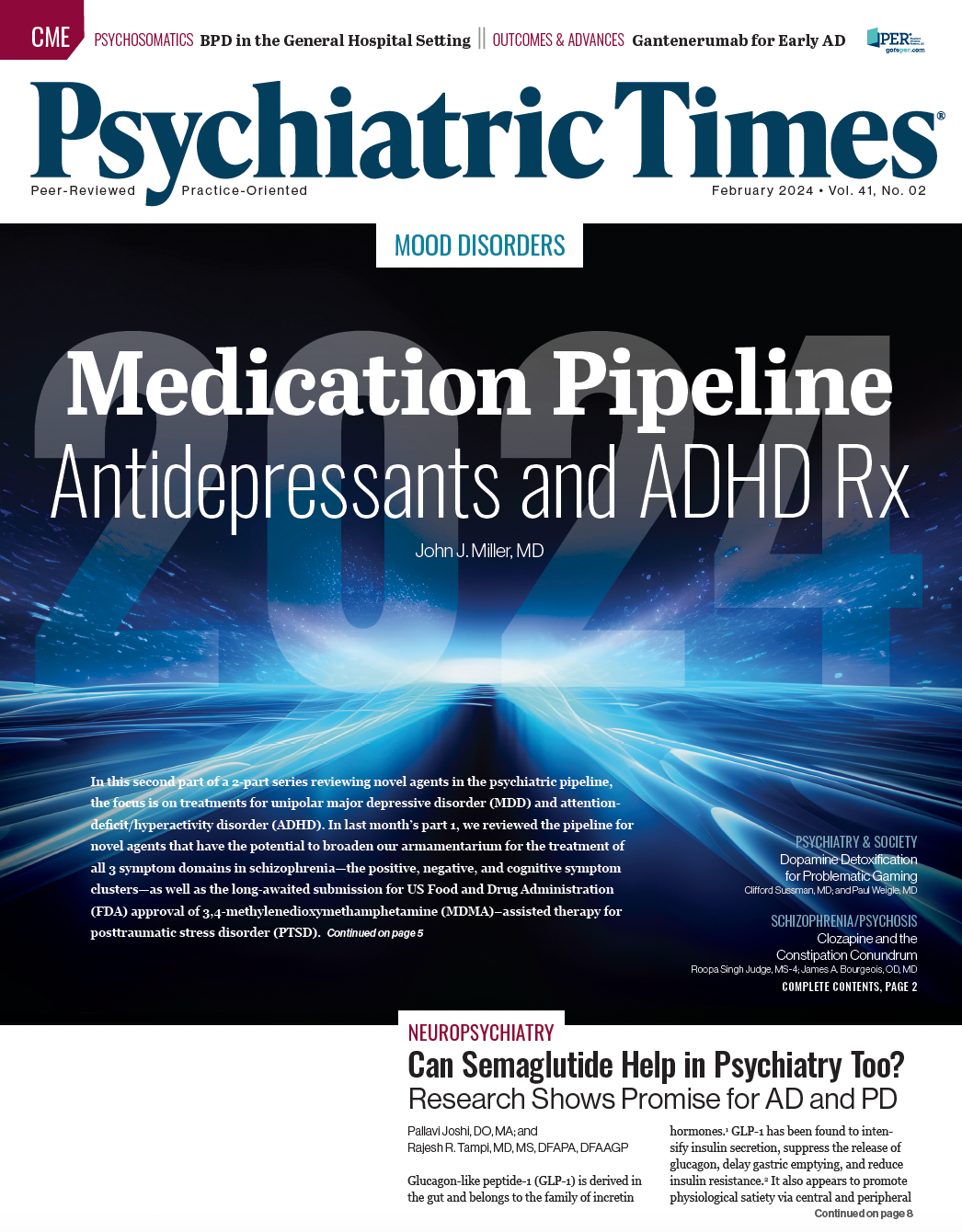Constipation Conundrum With Clozapine
Taras_Muroslavovuch/AdobeStock

Case Study
“Mr Frederick” is a 67-year-old man brought in by ambulance from a psychiatric health facility after 3 days of shortness of breath, fatigue, fever, and chills. His past medical history included chronic obstructive pulmonary disease (COPD), hypertension, hyperlipidemia, and schizophrenia. He was on a legal conservatorship due to a history of lethal violence. His chief complaint warranted admission and treatment for acute on chronic COPD exacerbation and chronic bronchopneumonia. His workup was notable for leukocytosis, normocytic anemia, and elevated neutrophil count. His renal function and hepatic function were normal.
However, the admitting internal medicine team directed their attention to new concerns: his distended, protuberant abdomen in the setting of constipation, and multiple episodes of coffee-grounds to brown-appearing emesis. Psychiatry was consulted for medical management of his psychiatric medications for his nothing by mouth (NPO) status due to concern for bowel obstruction versus ileus. Mr Frederick’s daily psychiatric medication regimen included clozapine 200 mg in the morning and 350 mg in the evening, valproate 500 mg in the morning and 1000 mg in the evening, topiramate 50 mg twice a day, and haloperidol 5 mg twice a day.
There was no input from the psychiatric facility regarding the presence or absence of current depressive, anxious, manic, or psychotic symptoms. It was unknown whether he had past suicide attempts. During the psychiatric interview, he was somnolent and minimally verbal. His behavior was somnolent with minimal to no eye contact. He was oriented to name, but not to place. His speech was limited, consisting of mumbled single-word responses. No major themes of delusions, paranoid ideations, perseverations, or suicidal or homicidal ideations were observed.
His conservator said that Mr Frederick’s appearance was consistent with his baseline behavior—typically “calm but disorganized.” Per his conservator’s communication with the psychiatric staff, the patient was mostly reserved, would sometimes giggle at internal voices, and had attempted to harm other residents on several occasions. He did not have a history of bowel obstruction or severe constipation.
For his NPO status during this hospitalization, it was initially decided to hold clozapine because of the concern for anticholinergic adverse effects. A recommendation was made for substituting intravenous (IV) formulations for haloperidol and valproate. His initial abdominal x-ray showed gas- and stool-filled loops of large bowel, but this was unable to exclude bowel obstruction due to a limited field of view. Subsequently, a CT scan of his abdomen and pelvis was obtained. It was notable for distended stomach with air-fluid level and wall thickening of the second portion of the duodenum. Findings were radiographically concerning for gastroduodenitis.
Given that he had 1 large bowel movement and no clear evidence of bowel obstruction on his CT abdomen and pelvis, the primary medical team decided against utilizing a nasogastric tube for decompression and instead continued a clear liquid diet. His gastroduodenitis was associated with a peptic ulcer, and he was continued on a proton pump inhibitor and aggressive bowel regimen. His oral clozapine was resumed to reduce the risks of needing to retitrate clozapine, and haloperidol was switched back from IV to oral formulation. At this time, the internal medicine team was concerned about his lethargic behavior. His oral valproate was resumed, although topiramate was held because it may have been contributing to slowed cognitive functioning. Mr Frederick’s mental status exam continued to be notable for minimal spontaneous movement, limited eye contact, and mumbled speech with an inability to formally assess cognition. Of note, his clozapine level (771 ng/mL) and norclozapine level (234 ng/mL) were significantly in the supratherapeutic range. The valproate acid and ammonia levels were within reference ranges. His nightly clozapine was decreased to 300 mg to assess if this would improve his arousal.
On day 13, his abdominal pain worsened. A repeat abdominal x-ray and CT scan of his abdomen and pelvis were ordered in addition to resuming NPO status and holding laxatives to avoid further gas distension. The abdominal x-ray demonstrated gaseous distension of the large bowel that was concerning for obstruction or ileus (Figure). The CT noted gaseous distension of the transverse and descending colon without bowel obstruction. He continued with oral medications since bowel obstruction was ruled out. Given the presence of elevated clozapine level and findings suggestive of pseudo-obstruction, the nightly clozapine was further decreased to 200 mg to reduce anticholinergic effects.
Figure. Supine Abdominal Radiograph Demonstrating Gaseous Distension of Large Bowel

On day 16, a third abdominal x-ray was obtained due to worsened abdominal pain and distension. The findings indicated interval worsening of marked gaseous distension of the sigmoid colon.
On day 17, general surgery was consulted for colonic pseudo-obstruction. No acute surgical intervention was necessary. It was recommended to obtain abdominal x-ray imaging every 24 hours to monitor for colonic distention, initiate NPO status and nasogastric (NG) tube placement for decompression to manage colonic pseudo-obstruction, and consult gastroenterology for further management. Consequently, NG tube placement was completed due to risk of bowel perforation related to pseudo-obstruction. Per evaluation by gastroenterology, it was noted that Mr Frederick likely had Ogilvie syndrome, with a CT finding absent for mechanical obstruction. The most likely etiology was due to antipsychotics and prolonged bedbound status.
On day 18, there was again discussion regarding the use of clozapine, navigating risks and benefits in the setting of pseudo-obstruction. His ileus and pseudo-obstruction gave reason to further decrease clozapine dose, although this was at the risk of worsening Mr Frederick’s agitation and psychosis, especially with his history of violence at lower clozapine doses. His clozapine was decreased further to 100 mg twice a day, whereas the original regimen was 200 mg in the morning and 350 mg in the evening. To manage the risk of worsened agitation, his haloperidol was simultaneously increased to 10 mg twice a day. Per gastroenterology, he was not a good candidate for neostigmine due to risk of bronchospasm, given his severe COPD. For the persistent sigmoid dilation measuring 15 cm, he underwent colonic decompression with success.
On day 19, Mr Frederick removed the NG tube himself but was found to be more alert with improvement in the abdominal pain. His abdomen was now soft and nondistended. The primary team continued with polyethylene glycol 3350, sennosides, and bisacodyl for bowel care. His Ogilvie syndrome was noted to be improved. The consult-liaison psychiatry team continued his clozapine 100 mg twice a day, valproate 500 mg in the morning and 1000 mg in the evening, and haloperidol 10 mg twice a day.
On day 20, his mental status exam was notable for improvement in clarity of speech and engagement, with no overt delusions or agitation. He was medically clear for discharge and with improved independent ambulation at this time, pending placement at a psychiatric facility.
On day 27, his mental status exam demonstrated extrapyramidal symptoms, including pill rolling and perioral tremors, and themes of paranoia and homicidal ideation regarding an individual at his psychiatric facility. There was concern for exacerbation of psychosis following the decreased taper of the clozapine. For these reasons, the nightly dose of clozapine was increased to 125 mg to address continued psychosis. Additionally, haloperidol was decreased to 7.5 mg twice a day to address the new extrapyramidal symptoms.
On day 30, he continued to present with a disorganized thought process and themes of paranoia, but he had improvement in extrapyramidal symptoms. Due to the risk for paranoia and psychosis with his history of violent behavior, his nightly clozapine was increased to 150 mg.
Mr Frederick was ultimately discharged on day 32 to return to his psychiatric facility. The final abdominal x-ray demonstrated resolution of dilation of the large bowel and nonobstructive bowel gas pattern. Because his psychiatric medications were modified while inpatient, it was recommended to his next physicians to consider titrating medications back to prior doses as needed and continue regular bowel care.
Discussion
Clozapine is known to be an effective medication for patients with schizophrenia who are resistant to treatment with other antipsychotics and/or for persistent suicidal behavior. Although clozapine has several adverse effects (Table), it should be emphasized to psychiatrists that the more common of these include its anticholinergic properties, including delirium and gastrointestinal (GI) hypomotility.1 It is reported that 14% of patients taking clozapine experience constipation.1 In a 2016 study that looked at Medicaid data from 2001 to 2009, the differential effectiveness between clozapine and a standard antipsychotic in treatment for schizophrenia was compared. Clozapine was associated with a significantly increased incidence of intestinal obstruction compared with patients receiving the standard antipsychotic (0.9% versus 0.3%; HR, 2.50; 95% CI, 0.97-6.44).2
Table. Adverse Effects of Clozapine1

This case highlights a basic but salient learning point surrounding the adverse effects of clozapine and the diagnosis of acute colonic pseudo-obstruction, or Ogilvie syndrome, a dilation of part or all of the colon without mechanical obstruction. The etiology of acute colonic pseudo-obstruction has not yet been completely identified but is theorized in part to be caused by a decrease or disturbance in parasympathetic activity.3 There are various inciting factors such as exacerbation of disease, various types of surgery, and/or pharmacologic agents with anticholinergic effects including opioids, tricyclic antidepressants, certain antipsychotics, antiparkinsonian medications, or calcium channel inhibitors.3,4
In this case, clozapine was a strong risk factor for Ogilvie syndrome. A cross-sectional study in 2016 aimed to determine the colonic transit times of antipsychotics such as clozapine due to the common adverse effects of obstruction or ischemia.5 There was a significant difference wherein patients taking clozapine had a median transit time of 104.5 hours, which was 4 times longer compared with other antipsychotics (P < .0001), whereas patients not prescribed clozapine had a median transit time of 23 hours.5 There was a positive correlation between longer colonic transit times and higher clozapine plasma level.5 It merits attention that a high serum clozapine level, as opposed to just minimally therapeutic levels, may be associated with a presentation of Ogilvie syndrome alongside the profound hypomotility effects. Conversely, it may also be theorized that lower doses of clozapine leading to a lower clozapine serum level might make recurrent cases of Ogilvie syndrome less likely. Overall, it is important that acute colonic pseudo-obstruction be considered in patients taking anticholinergic medications who present with abdominal distension, nausea or emesis, pain, or constipation.
It is pertinent to note that patients with schizophrenia can often present with blunted affect and negative symptoms, as with Mr Frederick. This may be associated with either difficulty with or inability to fully perceive or communicate emotions or pain.6 In this case, the mental status exam was limited because of his minimally conversant behavior. The psychiatry team was concerned about the possible sedative effects of clozapine, with the elevated serum levels, and topiramate. Given this possibility and the risk for decreased verbal expression, psychiatrists should encourage routine monitoring for adverse effects of constipation and ileus in this patient population, especially with the increased risk of delirium as well. Although constipation or abdominal pain may appear minor and common, a delay in management can result in fecal impaction, megacolon, intestinal obstruction, and/or sepsis secondary to perforation or necrosis.7
The circumstances of this case raise an interesting but challenging conversation regarding balancing the risks of constipation and pseudo-obstruction versus benefits of management of treatment-resistant schizophrenia with clozapine. In a patient such as Mr Frederick, who is taking regular clozapine, valproate, and haloperidol, it is axiomatic that his schizophrenia was refractory to other standard treatments. Clozapine was a critical component for his optimized functioning. The gradual reduction of his clozapine in the setting of the acute colonic pseudo-obstruction eventually resulted in increased paranoia and agitation, requiring a 1:1 sitter for the safety of the patient and staff.
Whether this emergence of psychotic symptoms represents a recurrence of schizophrenia and/or new onset delirium can be a difficult ascertainment. This was consistent with his reported past behavior while taking lower doses of clozapine. The psychiatry consultant subsequently increased the nightly dose of clozapine to strive for the goal of therapeutic benefit, although his discharge instructions for clozapine doses were relatively lower compared with his doses on admission. It is likely that he would continue to require daily assessment and modification to the clozapine regimen until there was a perceived improvement in his disorganized thoughts and behavior. However, this accentuates the issue once more: To optimize psychiatric function in schizophrenia, will increasing the dose of clozapine then risk recurrence of intestinal pseudo-obstruction?
Concluding Thoughts
Psychiatrists should be aware of the constipation conundrum with clozapine. It is a balancing act for therapeutic benefit in managing schizophrenia and risk for GI hypomotility and acute colonic pseudo-obstruction. Patients on clozapine should receive a dietary bowel regimen to minimize the risks of colonic dysmotility. There needs to be greater attention and treatment for the anticholinergic effects to reduce the risk of morbidity and mortality from this common yet potentially serious complication. Patients taking clozapine should not receive other anticholinergic medication, including tricyclic antidepressants and paroxetine.
Psychiatrists should collaborate with other physicians in monitoring patients for constipation and advise a high-fiber diet, liberal fluids by mouth, and exercise, in addition to bowel care with fiber or laxative supplements. Any report of GI distress in a patient on clozapine mandates an assessment for GI dysmotility. Monitoring clozapine serum levels may be considered. For patients unable to tolerate the anticholinergic adverse effects of clozapine, optimization of less anticholinergic antipsychotics can be considered in lieu of clozapine. As patients age, they may be less able to tolerate the anticholinergic effects of clozapine. Finally, psychiatrists should consider a course of electroconvulsive therapy for patients with treatment-refractory schizophrenia who experience GI obstruction or other serious adverse effects from clozapine.
Ms Judge is a medical student at the University of California Davis School of Medicine in Sacramento.
Dr Bourgeois is vice chair of hospital psychiatry services at the University of California Davis Medical Center in Sacramento.
References
1. Young CR, Bowers MB Jr, Mazure CM. Management of the adverse effects of clozapine. Schizophr Bull. 1998;24(3):381-390.
2. Stroup TS, Gerhard T, Crystal S, et al. Comparative effectiveness of clozapine and standard antipsychotic treatment in adults with schizophrenia. Am J Psychiatry. 2016;173(2):166-173.
3. Pereira P, Djeudji F, Leduc P, et al. Ogilvie’s syndrome-acute colonic pseudo-obstruction. J Visc Surg. 2015;152(2):99-105.
4. Ross SW, Oommen B, Wormer BA, et al. Acute colonic pseudo-obstruction: defining the epidemiology, treatment, and adverse outcomes of Ogilvie’s syndrome. Am Surg. 2016;82(2):102-111.
5. Every-Palmer S, Nowitz M, Stanley J, et al. Clozapine-treated patients have marked gastrointestinal hypomotility, the probable basis of life-threatening gastrointestinal complications: a cross sectional study. EBioMedicine. 2016;5:125-134.
6. Kring AM, Elis O. Emotion deficits in people with schizophrenia. Annu Rev Clin Psychol. 2013;9:409-433.
7. West S, Rowbotham D, Xiong G, Kenedi C. Clozapine induced gastrointestinal hypomotility: A potentially life threatening adverse event. A review of the literature. Gen Hosp Psychiatry. 2017;46:32-37.

